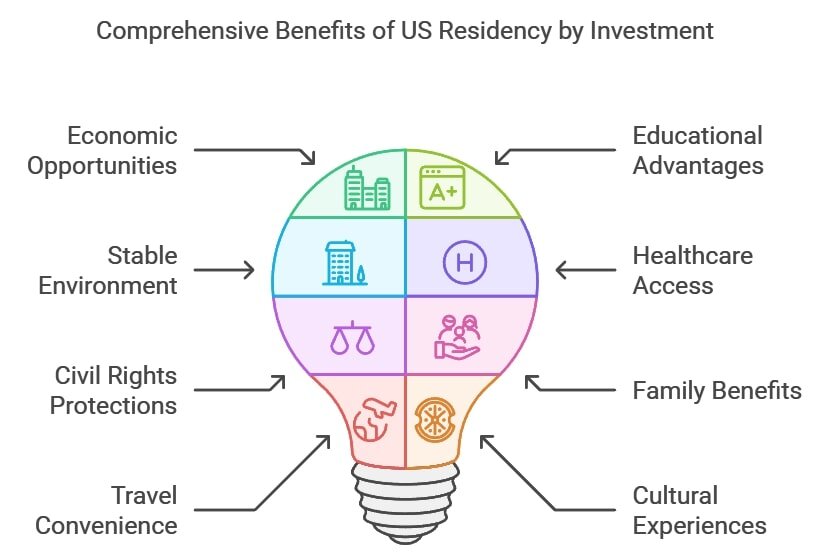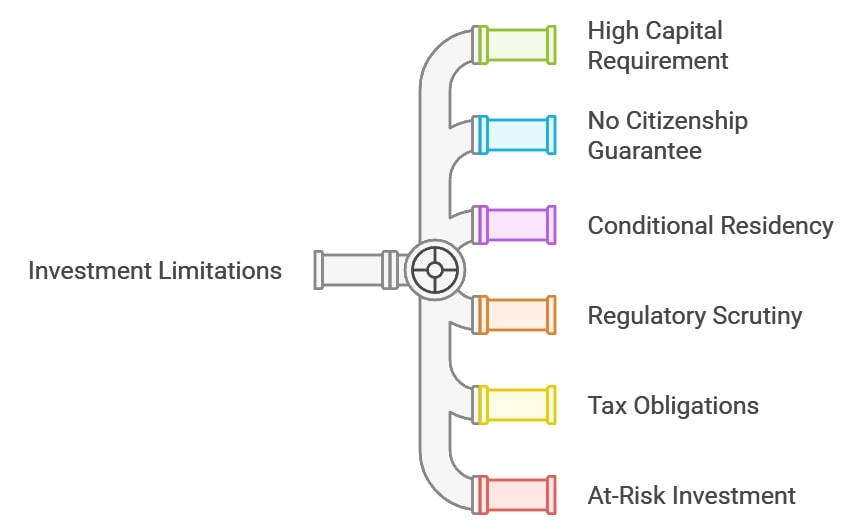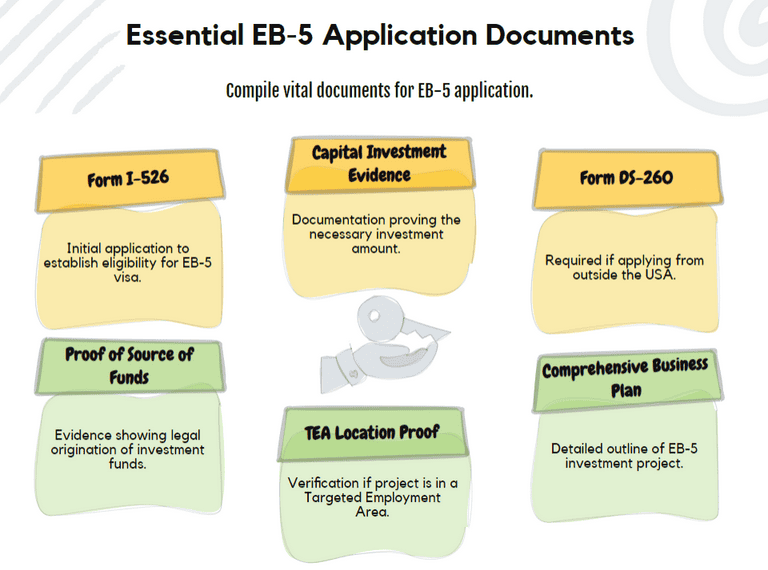USA Residency By Investment
Boost Your Freedom Without Compromise.
- Who offers the CHEAPEST program available.
- Who offers the BEST program available.
- What you need to qualify?

- The United States offers the EB-5 Visa Program as its primary residency by investment option, requiring a minimum investment of $800,000 in a Targeted Employment Area (TEA) or $1,050,000 outside of these areas, leading to the creation or preservation of at least ten full-time jobs for U.S. workers.
- Investment thresholds and requirements for the EB-5 program are designed to stimulate economic growth through foreign investment while offering investors and their immediate families a pathway to permanent residency in the U.S.
- Benefits include access to a vast and diverse market, high-quality education systems, and a stable political environment, along with the long-term potential for citizenship.
- The process involves submitting an I-526 petition, investing the required capital in a qualifying project, and upon approval, applying for a conditional green card. The final step is to remove conditions on residency after proving job creation through the I-829 petition.
- The timeline can vary significantly, with the entire process typically taking several years, depending on USCIS processing times and the success of the investment in meeting program requirements.
The United States of America, home to a staggering 328 million people and boasting the world's largest GDP, has long been a sought-after destination for many.
If you have the resources, you can secure permanent residency in this competitive global powerhouse by making a significant investment in the US economy.
The USA’s EB-5 visa program invites high-net-worth investors and entrepreneurs to contribute to its economy in return for US permanent residency.
In This Article, You Will Discover:
Stay with us as we tease out the intricacies of the USA residency by investment program, helping you discern if this is the right move for you.
Let's chart your course to a future in the USA…
*Disclaimer: All amounts quoted in this article were correct and accurate at time of publication and may have shifted since.
- Who offers the CHEAPEST program available.
- Who offers the BEST program available.
- What you need to qualify?
 Free Consultation
Free Consultation Easy to Use
Easy to Use 100% Safe & Secure
100% Safe & Secure
What Are the Benefits of Residency by Investment in the USA?
The benefits of residency by investment in the USA are vast, from educational advantages to the competitive edge of operating in a leading global economy.

Our experts have summarized the main benefits below:
- Economic opportunities: Residents will get access to one of the world's most dynamic and diversified economies, providing a range of business, investment, and employment opportunities.
- Educational advantages: Residents are eligible for in-state tuition rates at renowned American universities and schools, offering world-class education.
- Stable environment: The USA boasts a stable political climate, robust legal system, and advanced infrastructure, ideal for both personal and business ventures.
- Healthcare access: US residency allows access to advanced medical facilities and healthcare services in the country.
- Civil rights protections: The US legal infrastructure and constitution render it one of the most progressive, empowering, and tolerant places on the planet to live.
- Family benefits: There are opportunities for family members to live, work, and study in the USA, often extending to spouses and children.
- Travel convenience: It’s easier to travel to and from the USA, potentially with reduced visa restrictions for other countries based on a US residency status.
- Cultural experiences: There’s an immersion into a diverse cultural landscape, allowing residents to partake in a plethora of American experiences and traditions.
- Potential pathway to citizenship: Over time, residency by investment can pave the way for a more straightforward path to US citizenship.
- Asset protection: The US legal system provides robust mechanisms for asset protection and diverse investment opportunities.
- Networking: Residents get access to a vast network of professionals, entrepreneurs, and business entities, which fosters growth and collaboration.
What Are the Limitations of Residency by Investment in the USA?
The limitations of residency by investment in the USA are worth noting, given the risk factor involved in the required investment.

We want you to be fully informed, so here’s our expert summary of the main limitations to consider:
- Significant investment requirement: The USA’s residency by investment program (namely the EB-5 visa) is one of the most expensive programs in the world. A substantial amount of capital is required upfront, which might not be feasible for every investor.
- No guaranteed citizenship: Residency by investment doesn’t directly grant US citizenship; separate applications and eligibility criteria apply.
- Conditional permanent residency: Your initial permanent residency obtained under the EB-5 visa is conditional. You’ll qualify for unconditional permanent residency after 2 years if you’ve met all requirements of the EB-5 program.
- Regulatory scrutiny: Investors may face thorough vetting processes, background checks, and rigorous scrutiny to ensure the legitimacy of their funds and compliance with the mandates of the program.
- Tax implications: Residents might be subjected to the US global tax system, requiring them to report worldwide income and assets.
- At-risk investment: Your investment under the EB-5 program is specifically required to be “at risk”, meaning that there’s no guarantee of a return on your investment. This puts significant pressure on you as the investor.
- Economic fluctuations: The value of the investment can fluctuate based on economic factors.
- Complex legal navigation: The process often requires navigating complex legal pathways, which might necessitate hiring legal professionals, adding to the cost.
Learn More: EB-5 Visa Benefits and Risks
Which Investment Types Qualify for Residency by Investment in the USA?
The investment type that qualifies for residency by investment in the USA is limited to business investment.
Importantly, your business investment must adhere to the following criteria to qualify as a worthy EB-5 investment:
- You must invest in a new commercial enterprise (this is defined as a newly created business or a business established after November 29, 1990).
- The company you invest in must be for-profit.
- The company must generate at least 10 jobs for US workers and maintain them for at least 2 years.
You can either make a direct investment or you can invest via a regional center.
The difference between direct investment and regional center investment is detailed below:
Direct Investment
As the name implies, the direct investment route allows you to invest directly in your chosen enterprise.
This means that you’ll be directly responsible for managing the investment on a day-to-day basis.
This means
You’ll be solely responsible for the success or failure of your investment and for meeting the base requirements of the EB-5 program.
Regional Center Investment
Regional centers are designated entities that pool the funds of investors into investment projects that are facilitated and managed by the regional center.
Regional centers are only legitimate if they’re approved by the United States Citizenship and Immigration Services (USCIS).
What’s the upshot?
By investing via a regional center, you have less control over how your investment is managed.
On the other hand, the regional center takes on the responsibility of meeting other requirements of the EB-5 program (such as job creation).
Our advice?
If you choose to invest via a regional center, select one with a proven success rate.
Learn More: Most Successful EB-5 Regional Centers
What Are the Eligibility Requirements for Residency by Investment in the USA?
The eligibility requirements for residency by investment in the USA are highly specific, so you'll have a good sense of whether or not you qualify.
We’ve broken it down for you:
Minimum Investment Amount to Qualify
The minimum investment amount to qualify for residency by investment in the US varies depending on the geographical region you’re investing in.
The minimum investment amount will be either of the following:1
- US$1,05 million
- US$800,000 if you invest in a Targeted Employment Area (TEA)
“What’s a Targeted Employment Area?” we hear you ask.
Targeted Employment Areas are geographical areas in the USA that are either experiencing high unemployment or are considered rural.
Language Requirements to Qualify
There are no language requirements to qualify for the EB-5 visa.
Nationalities Restricted from Applying
All nationalities are invited to apply for the EB-5 visa.2
However
Given the limited number of EB-5 visas available annually, certain nationalities may experience greater application delays if the volume of applications from that country is significantly high.
Learn More: Who’s Eligible to Apply for an EB-5 Visa?
Will My Dependents Be Included Under My US Residency Permit?
Yes, your dependents will be included under your permanent residency permit.
How Long is the EB-5 Visa Valid & Can It Be Extended?
The validity period of the EB-5 visa is an important aspect to understand on your path to US permanent residency.
Initially, you’re awarded conditional permanent residency, after which you may apply to have the conditions removed.
Here are the details:
Validity Period
Your initial conditional permanent residency will be valid for 2 years.
Visa Extension
After the initial 2 years (assuming you’ve met all the deliverables of the EB-5 program), you need to apply to remove the conditions from your US permanent residency status.
This will confer unconditional permanent residency status on you, which is the desired endpoint to your EB-5 journey.
What’s the Application Process for Residency by Investment in the USA?
The application process for residency by investment in the USA is extremely rigorous and requires comprehensive documentation and preparation.
Our team of experts has compiled a handy EB-5 planning checklist, helping you organize yourself for the EB-5 application process.
Learn More: EB-5 Planning Checklist
Below, we’ll break down the basic process for you.
Step-by-Step Application Process
For your convenience, we’ve broken down the EB-5 application process into 7 handy steps.
You should go about it in the following way:
- Step 1: Choose a reputable immigration attorney.
- Step 2: Select your preferred investment project and develop a business plan.
- Step 3: Make your investment.
- Step 4: File your EB-5 petition (application).
- Step 5: Attend a consulate interview (if applying from outside the USA)
- Step 6: Apply for conditional permanent residency.
- Step 7: Removal of conditions
Learn More: How to Apply for an EB-5 Visa
Required Documents
Your documentation needs to be complete and accurate to ensure that you sail through the intense EB-5 due diligence process.

We’ve summarized the required documents for an EB-5 application below:
- Form I-526
- Form DS-260 (if applying from outside the USA)
- Evidence of the required capital investment
- Proof of source of funds
- Business plan
- Proof that the EB-5 project is located in a TEA (if applicable)
- Articles of incorporation or organization for the new commercial enterprise
- Partnership or operating agreements (if applicable)
- Evidence that your investment will create 10 jobs for US workers
- Proof of business or asset ownership
- Copy of all business and/or professional licenses
- Last 5 years of tax returns (business or personal)
- Last 5 years of bank statements (business or personal)
- Proof of ownership for other sources of capital used for the investment
- Financial statements for every business
- Passport copies
- Birth certificates for all family members that are included in the application
- Marriage certificate (if applicable)
- Divorce or death certificates (if applicable)
- Police clearance certificates from the countries where you’ve lived
- Pending governmental civil or criminal actions, certified copies of judgments, or private civil actions against the petitioner within or outside of the US within the last 15 years
- Military records (if applicable)
- Copies of previous immigration applications
- Photographs
- Medical examination
As you can see, the list of required documentation is indeed very extensive.
Learn More: How to Apply for an EB-5 Visa
What Costs Are Involved in Getting Residency by Investment in the USA?
The costs involved in getting residency by investment in the USA range from the application costs to legal costs and oft-unexpected additional costs.
The substantial investment amount is only one aspect of the costs you’re likely to incur.
To compile an effective budget for your EB-5 journey, it’ll help to plan for the following costs and fees:
Application Costs
The EB-5 application is also referred to as an Immigration Petition by Alien Investor, or I-526 petition.
It costs approximately US$3,765.3
Legal & Advisory Costs
Legal and advisory costs will constitute a large portion of what you can expect to spend on your EB-5 application process.
We’ve summarized some of the main ones to expect here:
- Immigration attorney fees
- Business plan writing
- Due diligence fees
- Financial advisor fees
- Translation services (if applicable)
Additional Associated Costs
Depending on whether you invest via a regional center and on your approach to document preparation and collation, you can expect to pay certain additional fees associated with the EB-5 process.
Here are a few of the main ones to expect:
- USCIS filing fees for processing the I-526 and I-829 petitions, key forms in the EB-5 process
- Administrative fees associated with the management and oversight of the investment, especially if investing through a regional center
- Travel expenses
- Medical examination
- Document procurement
- Adjustment of status fee if you’re applying from within the US
Learn More: EB-5 Costs, Charges, & Fees
What’s the Processing Time for the US EB-5 Visa?
The processing time for EB-5 visa applications varies, depending on several factors.
Take a look:
Average Processing Time
Typically, the USCIS takes 18 to 24 months to process EB-5 applications.
Factors Affecting Processing Time
Various factors can enhance or interfere with the processing times of EB-5 applications.
These are some of the factors that tend to influence processing times most significantly:
- Volume of applications: Higher numbers of applicants can lead to longer processing times due to the increased workload for USCIS.
- Source of investment funds: Complex or non-traditional sources may require longer review periods to verify compliance with regulations.
- Regional Center involvement: Applications involving regional centers might experience different processing times compared to direct investments.
- Requests for evidence (RFE): If the USCIS requests additional documentation or clarifications, this can delay the application process.
- Country of origin: Some countries might have higher volumes of applicants, leading to annual caps and potential visa backlogs.
- Project complexity: More intricate or multifaceted investment projects may take longer to review and assess.
- Changes in regulations: Any updates or modifications in EB-5 rules and policies could affect the speed of processing.
- USCIS workload: The overall workload and staffing at USCIS can influence the processing times.
- Accuracy of application: Incomplete or incorrectly filled forms can lead to delays or return of applications.
- Security clearances: Background checks and security clearances can influence the processing duration, especially if there are complications.
- Legal issues: If there are any legal issues or disputes associated with the investment project or the investor, this can cause delays.
It's worth noting
While there are general processing time estimates, individual cases can vary widely based on a combination of the above factors.
Expedited Processing Options
The USCIS doesn’t offer a formal expedited processing option.
Ensuring that you plan adequately and submit a complete and comprehensive application will help to facilitate a smooth processing timeline.
How Soon Will I Receive My Residency Permit After My EB-5 Application Is Approved?
After your EB-5 application is approved, you’ll apply for an adjustment or status.
Once this is approved, it generally takes around 6 months to receive your US residency permit (or green card).
What Are the Tax Implications of Residency in the USA?
The tax implications of achieving residency by investment in the USA are significant and far-reaching, owing to the fact that EB-5 visa-holders become liable to be taxed on their worldwide income.
For your convenience, we’ve summarized the most important tax implications below:
- Worldwide income taxation: Once you become a US tax resident (which includes green card holders), you’re subject to US taxation on your worldwide income, regardless of where it’s earned.
- Estate and gift tax: US tax residents are subject to US estate and gift taxes on their worldwide assets.
- Tax on capital gains: Any profit made from the sale of property, including real estate and stocks, can be subject to capital gains tax.
- FBAR reporting: US tax residents with financial interests in or signature authority over foreign financial accounts may need to report these accounts annually if the aggregate value exceeds certain thresholds.
- FATCA compliance: The Foreign Account Tax Compliance Act (FATCA) requires foreign banks and other financial institutions to report on the foreign assets held by their US account holders. This may impact U.S. tax residents with accounts overseas.
- Exit tax: Green card holders who decide to give up their green card (after holding it for at least 8 out of the last 15 years) might be considered "covered expatriates" and subject to an exit tax, which is calculated as if they sold all their assets the day before expatriating.
- State and local taxes: In addition to federal taxes, many states and local municipalities have their own income, property, and sales taxes. The implications vary widely depending on where one resides in the US.
- Tax treaty benefits: The US has tax treaties with several countries that can help prevent double taxation. It's crucial to be aware of any such treaties that might apply to your situation.
- Annual reporting: US tax residents must file an annual income tax return, even if no tax is due.
- Self-employment taxes: Those who are self-employed in the US will be subject to self-employment taxes, which cover Social Security and Medicare.
- Tax on passive income: Certain types of passive income, such as interest, dividends, and rents, may be subject to different tax rates or withholding requirements.
It's crucial to engage with a US tax professional familiar with international tax issues to ensure full compliance and optimization of your tax position.
Learn More: What Are the Tax Implications of an EB-5 Visa?
Is Residency by Investment in the USA a Pathway to US Citizenship?
Yes, residency by investment in the USA is a potential pathway to US citizenship.
If you maintain your permanent residency status in the USA for a period of time (usually 5 years), you could be eligible to apply for US citizenship.4
Common Questions
What Rights Do US Permanent Residents Have?
Can I Get US Permanent Residency by Buying Real Estate?
How Do I Choose the Right Regional Center?
How Much Money Do I Need to Get Permanent Residency in the US?
What’s a Green Card?
Is There an Annual Cap on EB-5 Visas?
How Risky Is Residency by Investment in the USA?
What’s the Easiest Way to Immigrate to the USA?
Do I Get My EB-5 Investment Back?
In Conclusion
The EB-5 visa offers a compelling pathway to US residency by investment, blending economic opportunities with the potential for a life in the United States.
While it comes with specific criteria and financial commitments, the rewards include a direct route to permanent residency and, eventually, citizenship.
As with any significant decision, thorough research and professional consultation are essential for a successful EB-5 journey.
Our dedicated team at WorldPassports is here to help support you on that journey!
Perhaps you’d like to check out other residency by investment opportunities in the Americas.
We have a host of articles to help inform you.
Learn More: American Countries Offering Residency by Investment
- Who offers the CHEAPEST program available.
- Who offers the BEST program available.
- What you need to qualify?
 Free Consultation
Free Consultation Easy to Use
Easy to Use 100% Safe & Secure
100% Safe & Secure







